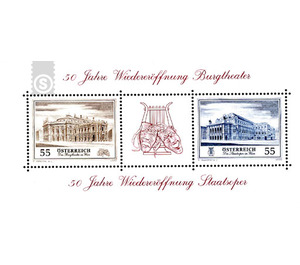50 years Reopening Burgtheater, Staatsoper Vienna - Austria / II. Republic of Austria 2005
Theme: Art & Culture
| Country | Austria / II. Republic of Austria |
| Issue Date | 2005 |
| Edition Issued | 500,000 |
| Item Type | Block |
| Chronological Chapter | OOS-OE2 |
| Chronological Issue Number | Block 30 |
| SID | 172749 |
| In 50 Wishlists | |
The Vienna State Opera is one of the best opera houses in the world. The Vienna Burgtheater is one of the leading European theaters. In 2005, both prestigious houses celebrated brilliantly the reopening after the destruction in the Second World War. Both stages are closely linked, not only because they are involved in the currently largest theater company in the world, the Bundestheater Holding. Both houses, formerly Hoftheater in the monarchy, were built after the destruction of the city walls and the defenses become useless on the new Vienna Ring Road: the present Burgtheater after plans by Gottfried Semper and Karl Hasenauer and the opera by August von Siccardsburg and Eduard van der Nüll , Both houses were opened at intervals of only a few years: the opera on 25. 5. 1869 and the Burgtheater on 14.10.1888. Despite the turmoil of the World Wars, the two stages could continue to operate, but the Second World War did not stop at the strongholds of culture, even though it had long looked as if the venerable houses would remain relatively unscathed. The great destruction of both buildings came just before the end of the war. The opera was destroyed on March 12, 1945 in one of the heaviest major bomb attacks on the capital to a large extent, spared only the main facade with the main vestibule, the main staircase with the festivals, the Schwindfoyer and the tea salon. On the same day, the Burgtheater, which had previously been damaged, was hit by the bombs and a month later the auditorium burned down. In total, in the 3 years from 1943-45, about 80,000 tons of bombs fell on Austria, killing about 30,000 people and destroying more than 12,000 buildings. But the bombing could not break the Austrians, even the cultural scene could be maintained. There were still suitable, undamaged buildings in Vienna, which were playable. The opera opened in the House of the Volksoper on 1.5.1945 provisional operation. Ing. Julius Raab, the new Secretary of State for Public Works, announced on May 24, 1945, the reconstruction of the Vienna State Opera as a symbol for the reconstruction of the whole of Austria. On October 6, 1945, the most important repair work in the Theater an der Wien was completed and the opera got a second provisional stage with this traditional house. The ensemble of the Burgtheater found asylum in the "Etablissement Ronacher". It took 10 years for both houses to be rebuilt and equipped with state-of-the-art technology. The Burgtheater opened on 15.10. 1955 with Grillparzer's "King Ottokar's luck and end" his doors. The Staatsoper opened with a similarly symbolic and brilliant performance of Beethoven's "Fidelio" under Karl Böhm on 5 November 1955. The Austrian Television broadcast this opera evening as the first sign of life of the young republic throughout the world.


